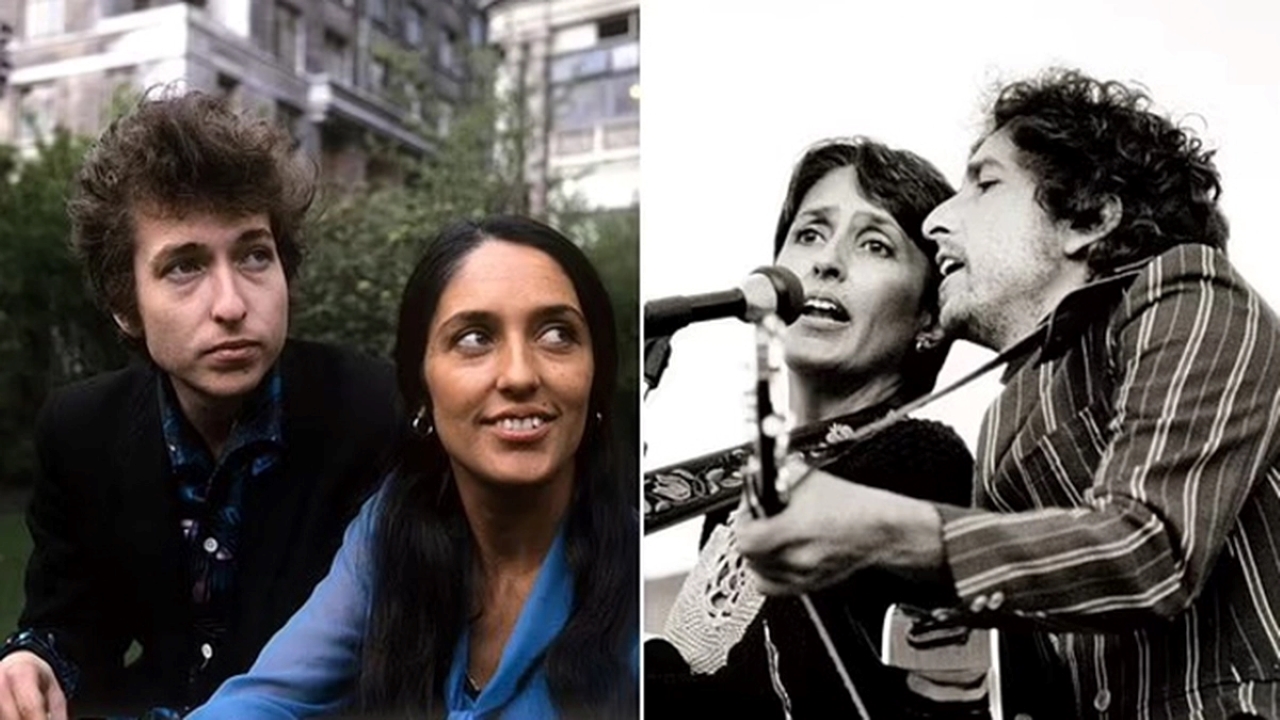🌿 When Two Voices Merged Into a Movement
In the early 1960s, Bob Dylan was still a scruffy newcomer from Minnesota, wandering into the New York folk scene with little more than a raspy voice, a guitar, and a head full of restless verses. Joan Baez, on the other hand, had already captivated America with her clear, operatic voice and magnetic stage presence. At just 21, she had a Carnegie Hall performance under her belt and had become a queen of folk revival.
Their meeting seemed inevitable. When Baez first heard Dylan sing, she was struck by his lyrics more than his voice. “He was like a little boy with a big idea,” she’d later say. But the words… those words hit her like thunder. Within months, she began inviting Dylan onstage during her concerts, giving him an audience far bigger than he could draw on his own. It wasn’t just musical chemistry — it was romantic too.
They were young, intense, and united by something larger than love: a belief that music could change the world. And for a while, it did.

🔥 Love, Fame, and Friction
By 1963, Baez was already a star. But she made space for Dylan in her spotlight, introducing him at venues, festivals, and protests. In London, in front of a skeptical crowd, she brought Dylan out and told them to “listen to the words.” The world started paying attention.
But as Dylan’s fame skyrocketed, so did his ego. He grew increasingly uncomfortable with being labeled a protest singer, and began drifting toward more cryptic, personal lyrics. Baez, still deeply rooted in activism, felt this shift as a slow betrayal — not just of their shared ideals, but of their bond.
During Dylan’s 1965 UK tour — documented in Don’t Look Back — Baez followed him, hoping to rekindle their connection. But Dylan, now surrounded by hangers-on and handlers, barely acknowledged her. In the film, she’s seen singing softly alone in a hotel room while Dylan laughs with others in the background. It’s painful. Raw. Real.
Joan Baez, once the woman who gave Dylan a stage, had become a ghost in his spotlight.
🎙️ The Song That Said Everything: “Diamonds & Rust”
In 1975, nearly a decade after their romance had collapsed, Baez released a song that remains one of her most haunting: “Diamonds & Rust.”
It begins with a late-night phone call:
“Well I’ll be damned, here comes your ghost again…”
With poetic grace and quiet fury, Baez reflects on the rollercoaster of their love — from the giddy days in New York to the cold silences in London. She doesn’t name him, but the references are unmistakable: the “original vagabond,” the “eyes bluer than robin’s eggs,” and the memory of him writing poems in a hotel room, lost in his own world.
The song isn’t bitter. It’s mournful. Honest. A final letter never sent.
Dylan never publicly responded to the song, though he reportedly admired it. Maybe he recognized the truth in it. Maybe it hurt.
✊ Music, Protest, and Ideological Clashes
While Dylan retreated from political activism, Baez leaned in harder. She marched in Selma, was arrested during anti-draft protests, and performed in Vietnam under bomb-laced skies. Her voice was always loudest when the world needed it most.
This divergence became more than personal — it became symbolic. Dylan represented the artist escaping the weight of public expectation, while Baez stood for the activist who never abandoned her cause.
Their split wasn’t just about betrayal or neglect. It was about two people trying to carry the hopes of a generation — and breaking under the weight in very different ways.
🎸 When the Past Echoes Onstage
In 1975, Dylan launched the Rolling Thunder Revue, a chaotic, theatrical tour that brought Baez back into his orbit. Onstage, they sang duets — sometimes playfully, sometimes tensely. Offstage, they talked and laughed, even danced.
There was no rekindled romance, but there was something deeper: a reckoning. In one interview, Baez said, “I was finally able to see him as a human being, not just a symbol of my heartbreak.”
Their final chapter wasn’t dramatic or explosive. It was quiet. Two legends, older now, knowing they had changed each other — for better or worse.
🌕 The Legacy of Their Love
Today, when we listen to early Dylan, it’s impossible to forget Baez’s hand in shaping his path. And when Baez sings “Diamonds & Rust,” we hear not just a story of a love lost, but of a movement born and torn apart.
They were two sides of the same revolution — one that sang with defiance, hope, and heartbreak.
Baez never stopped singing for justice. Dylan never stopped chasing his own truth. But together, for a brief, shining moment, they made history — and left behind a love story that still echoes every time a young artist picks up a guitar and believes their song can matter.